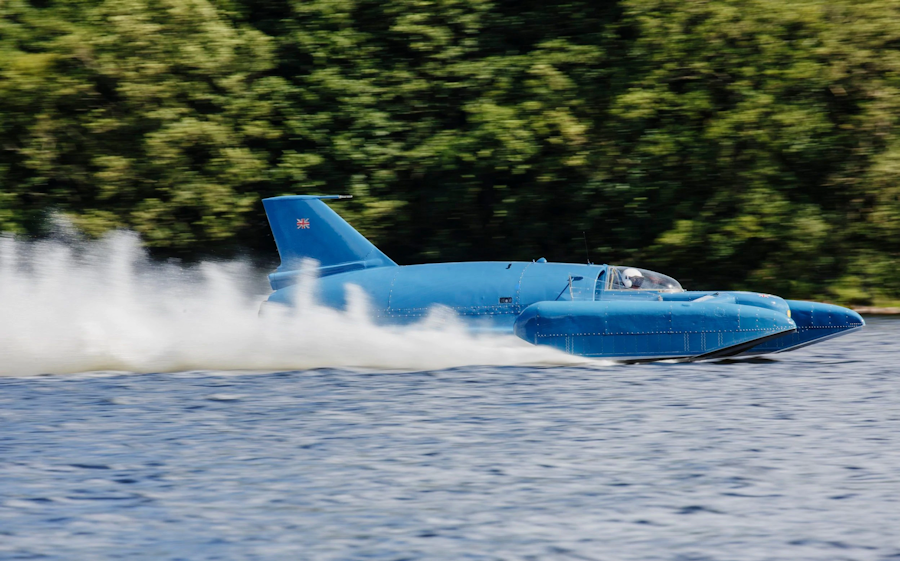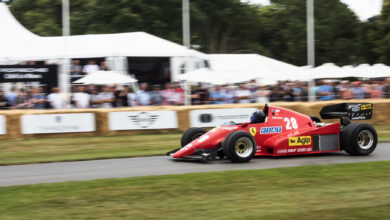
Podcast: Play in new window | Download
The World Water Speed Record is currently governed by the Union International Motonautique and is considered by many to be one of the most dangerous competitions in motorsport. In fact, since 1940 attempts to gain the record have claimed the lives of 85% of those who tried.
The record currently stands at 317mph, which was set in 1978 by Australian Ken Warby in the Spirit of Australia. Since the time of steam-powered boats new records have been set by only 16 people and between them they have set a new record 34 times.
Advances in boat design led to increased speeds being achieved in the late 19th and early 20th centuries. During this period men such as Nathanael Herreshoff and Charles Algernon Parsons held the record, utilising craft that reached speeds of 26.2 and 39.1 mph respectively. The last steam-powered record was set by Charles R. Flint in a boat he called ‘Arrow’ which achieved a speed of 45.06 mph in 1903.
As the next decade rolled around gasoline became increasingly important in efforts to break the record and allowed for additional speed to be achieved. It is at this point that Alexander Graham Bell, who achieved fame for inventing the telephone, began working with Frederick W. Baldwin to build the fastest boat in the world. They succeeded in 1919 when their ‘HD-4 Hydrofoil’ craft achieved a speed of 70.86 mph on the Bras d’Or Lake in Nova Scotia.
During the 1920s increasing attempts were being made on the record and American-made powerboats became dominant in the sport. It was during this period that Gar Wood began to rise to prominence, with his ‘Miss America’ boats which were capable of reaching in excess of 100 mph.
This increased competition brought with it increased popularity, with several people vying for the unofficial world record. The record was eventually made official and was ratified in 1928, with rules as to the exact conditions that must be achieved to compete for the record being laid out in 1930. It was during this period that the first high profile death in the competition occurred as British competitor Henry Seagrave lost his life in an attempt to improve the record he had just set at 98.8mph in his ‘Miss England 2’ racer.
A repaired Miss England 2 was subsequently used by Kaye Don to set a new mark of over 110mph on Lake Garda in 1931. However, Gar Wood was never far away from the record and reclaimed it with an average speed of 111.712mph in Miss America IX the following year.
Both Kaye Don and Gar Wood competed for the record throughout the 1930s, causing it to change hands several times. However, it was not until additional developments in boat design occurred that the most famous family to partake in the sport emerged.
In June 1937 famed World land speed record holder Malcolm Campbell entered the competition, with his ‘Blue Bird K3’ achieving a speed of 126.33 mph thanks to a variety of alterations to standard boat designs. This marked the end of Wood’s and Don’s dominance in the sport and signalled a move away from the hulking boats used in the 1930s to boats sporting a much sleeker and more aerodynamic design.
Campbell was also the first to begin experimenting with jet engines, renovating his ‘Blue Bird K4’ to incorporate one. His efforts with this new form of power failed however and he retired in 1945 after having set a new water speed record four times culminating in one that would stand for 11. This record was achieved on Coniston Water in England on 19 August 1939 with an average speed of 141.74 mph after he had replaced the jet engine in Blue Bird K4 with a more conventional Rolls Royce R gasoline engine.
After the record had been in the hands of the British for almost 13 years it was snatched away by the Americans when Stanley Sayres set the record on 26 June 1950 and then again on 7 July 1952 on Lake Washington with his boat Slo-Mo-Shun IV which achieved an average speed of 178.497mph. Slo-Mo-Shun would be the last propeller-driven craft to hold the record as 3 years after the previous record had been set, Donald Campbell arrived on the scene.
Campbell’s redesigned ‘Blue Bird K7’, which housed a Metropolitan-Vickers jet engine brought the record back to the Campbell family and to Britain in 1955 when the 200mph barrier was broken at Ullswater. Donald Campbell would go on to break his own record another six times, including his famous attempt at Lake Dumbleyung in Western Australia in 1964 that saw him achieve a speed of 276.33 mph in Blue Bird K7.
On 4 January 1967 a re-engined Blue Bird K7 returned to Coniston Water with Campbell at the controls and although he achieved 315mph on his first run, he lost control of Blue Bird on the return run at a speed of approximately 318mph. The boat rose into the air, somersaulted and disintegrated on impact with the water. Campbell was killed instantly and although a number of attempts were made, his body was not recovered until May 2001.
Shortly after Donald Campbell’s accident, Lee Taylor’s ‘Hustler’ boat broke the record, marking the end of the Campbell era. Since then the record has only been broken twice more and is currently held by Ken Warby’s ‘Spirit of Australia’ with a speed of 317.59 mph, which was set on 8 October 1978.
It seems that the World water speed record no longer holds the appeal that it did before Donald Campbell’s death. However, there are several projects that aim to break Warby’s record, though none have yet come to fruition.
Podcast: Play in new window | Download





